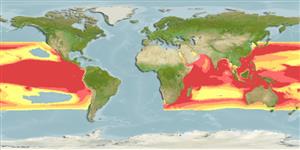Common names from other countries
Ελασμοβράγχιοι (καρχαρίες και σαλάχια) (sharks and rays) >
Lamniformes (Mackerel sharks) >
Alopiidae (Thresher sharks)
Etymology: Alopias: From alopex, Greek for fox, referring to the ancient vernacular “fox shark,” from its supposed cunning (ancients believed that when it took a bait, it swallowed the hook until it got to the cord, which it bit off and so escaped). (See ETYFish); pelagicus: Pelagic, (from pelagos, Greek for sea), referring to its “living in the upper layer of the sea,” in contrast to A. profundus [=superciliosus], which Nakamura believed dwelled on the “sea-bottom”). (See ETYFish).
Environment: milieu / climate zone / depth range / distribution range
Οικολογία
Θαλασσινό(ά); ωκεανόδρομο(ς) (Ref. 51243); εύρος βάθους 0 - 300 m (Ref. 106604), usually 0 - 150 m (Ref. 55167). Tropical; 40°N - 42°S, 16°E - 70°W (Ref. 54277)
Circumglobal. Indo-Pacific: Red Sea, Arabian Sea, Maldives (Ref. 30829), Somalia, South Africa, Western Australia, China, Taiwan, Japan, New Caledonia, Hawaiian Islands and Tahiti. Eastern Pacific: Gulf of California and the Galapagos. Reliable records lacking partly due to its confusion with Alopias vulpinus.
Length at first maturity / Μέγεθος / Βάρος / Age
Maturity: Lm 287.0, range 260 - 292 cm
Max length : 428 cm TL αρσενικό/απροσδιόριστο; (Ref. 106604); 383.0 cm TL (female); common length : 276 cm TL αρσενικό/απροσδιόριστο; (Ref. ); μεγ. αναφερόμενη ηλικία: 29 έτη (Ref. 48844)
Ραχιαίες άκανθες (συνολικά) : 0; Εδρικές άκανθες: 0. A small thresher with moderately large eyes, a broadly convex forehead, a very narrow caudal tip, and straight, broad-tipped pectoral fins (Ref. 5578). Upper lobe of caudal fin very long and strap-like, almost equal to length of rest of shark; lower lobe short but strong; terminal lobe very small (Ref. 13570). Dark blue on back and sides, underside white; no white patch over pectoral fin bases (Ref. 5578).
Primarily an oceanic species but sometimes close inshore (Ref. 247, 5578, 58302); neritic to oceanic, 0-152 m (Ref. 11230). Epipelagic (Ref. 58302). Mesopelagic in the tropics; may enter atoll lagoons (Ref. 37816). Stuns its prey with its tail, presumably feeding on small fishes and cephalopods (Ref. 6871). Ovoviviparous, embryos feeding on yolk sac and other ova produced by the mother (Ref. 43278, 50449). Sometimes caught by ski-boat anglers (Ref. 5578). Utilized for human consumption, liver oil for vitamin extraction, hides for leather, and fins for shark-fin soup (Ref. 13570). A very common catch in the tuna and shark longline, and tuna drift net fisheries (Ref.58048). Maximum and common size of males estimated from discussion in Ref. 247. Adult females may reach at least 330 cm TL (Ref. 47613).
Exhibit ovoviparity (aplacental viviparity), with embryos feeding on other ova produced by the mother (oophagy) after the yolk sac is absorbed (Ref. 50449, 42326). Usually with at least two young (Ref. 6871). Size at birth about 100 cm (Ref. 6871); 130-160 cm TL (Ref. 58048). Distinct pairing with embrace (Ref. 205).
Compagno, L.J.V., 1984. FAO Species Catalogue. Vol. 4. Sharks of the world. An annotated and illustrated catalogue of shark species known to date. Part 1 - Hexanchiformes to Lamniformes. FAO Fish. Synop. 125(4/1):1-249. Rome, FAO. (Ref. 247)
IUCN Red List Status (Ref. 130435)
Human uses
αλιεία: Εμπορικό(ά); αλιεία αναψυχής: ναί
Εργαλεία
Warning: mysqli::__construct(): (HY000/1040): Too many connections in /var/www/html/includes/speciessummary.lib.php on line 2104
Can't connect to MySQL database fbquizv2. Errorcode: Too many connections
